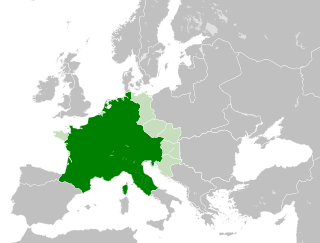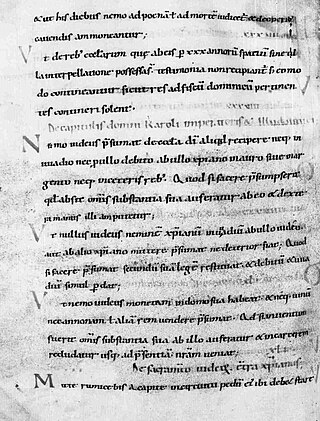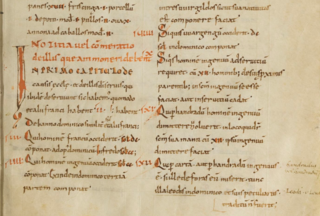Related Research Articles

The Carolingian Empire (800–888) was a large Frankish-dominated empire in western and central Europe during the Early Middle Ages. It was ruled by the Carolingian dynasty, which had ruled as kings of the Franks since 751 and as kings of the Lombards in Italy from 774. In 800, the Frankish king Charlemagne was crowned emperor in Rome by Pope Leo III in an effort to transfer the Roman Empire from Byzantine Empire to Europe. The Carolingian Empire is considered the first phase in the history of the Holy Roman Empire.
A missus dominicus, Latin for "envoy[s] of the lord [ruler]" or palace inspector, also known in Dutch as Zendgraaf, meaning "sent Graf", was an official commissioned by the Frankish king or Holy Roman Emperor to supervise the administration, mainly of justice, in parts of his dominions too remote for frequent personal visits. As such, the missus performed important intermediary functions between royal and local administrations. There are superficial points of comparison with the original Roman corrector, except that the missus was sent out on a regular basis. Four points made the missi effective as instruments of the centralized monarchy: the personal character of the missus, yearly change, isolation from local interests and the free choice of the king.

Francia, also called the Kingdom of the Franks, Frankish Kingdom, Frankland or Frankish Empire, was the largest post-Roman barbarian kingdom in Western Europe. It was ruled by the Franks during late antiquity and the Early Middle Ages. After the Treaty of Verdun in 843, West Francia became the predecessor of France, and East Francia became that of Germany. Francia was among the last surviving Germanic kingdoms from the Migration Period era before its partition in 843.

Pepin or Pippin, born Carloman, was the son of Charlemagne and King of the Lombards (781–810) under the authority of his father.
Pseudo-Isidore is the conventional name for the unknown Carolingian-era author behind an extensive corpus of influential forgeries. Pseudo-Isidore's main object was to provide accused bishops with an array of legal protections amounting to de facto immunity from trial and conviction; to secure episcopal autonomy within the diocese; and to defend the integrity of church property. The forgeries accomplished this goal, in part, by aiming to expand the legal jurisdiction of the Bishop of Rome.

The Chronicle of Moissac is an anonymous compilation that was discovered in the abbey of Moissac, but is now thought to have been compiled in the Catalan monastery of Ripoll in the end of the tenth century. Like most chronicles, it begins with Adam, but gains increasing interest for historians as it nears its end date of 828. Unfortunately, a folio with the entries covering the years 716–770 is missing. The only surviving manuscript of the Chronicle of Moissac dates from the later 11th century and is now in the French National Library in Paris.

The Royal Frankish Annals, also called the Annales Laurissenses maiores, are a series of annals composed in Latin in the Carolingian Francia, recording year-by-year the state of the monarchy from 741 to 829. Their authorship is unknown, though Wilhelm von Giesebrecht suggested that Arno of Salzburg was the author of an early section surviving in the copy at Lorsch Abbey. The Annals are believed to have been composed in successive sections by different authors, and then compiled.
Saint Ansegisus was a monastic reformer of the Franks.
Emil Seckel was a German jurist and law historian.

Quierzy, also known as Quierzy-sur-Oise, is a commune in the Aisne department in Hauts-de-France in northern France, straddling the Oise River between Noyon and Chauny.
The Lex Saxonum are a series of laws issued by Charlemagne between 782 and 803 as part of his plan to subdue the Saxon nation. The law is thus a compromise between the traditional customs and statutes of the pagan Saxons and the established laws of the Frankish Empire.
Benedict Levita, or Benedict the Deacon, is the pseudonym attached to a forged collection of capitularies that appeared in the ninth century.
The Lex Ripuaria, also spelled Lex Ribuaria, is a 7th-century collection of Germanic law, the laws of the Ripuarian Franks. It is a major influence on the Lex Saxonum of AD 802. The Lex Ripuaria originated about 630 around Cologne and has been described as a later development of the Frankish laws known from Lex Salica.

The Capitulary for the Jews is a set of six short legal prescriptions concerning Jews in the Carolingian Empire. They were gathered together and published under the title by which they are now known by Alfred Boretius in 1883, but only the first three and possibly the fourth are derived from a single source; the fifth and sixth are from an unrelated source. In one manuscript, the sixth "chapter" (capitulum) is said to have been taken "from Emperor Charles' statutes", indicating either Charlemagne or Charles the Bald. Its content, however, is inconsistent with the known Jewish policies of these emperors.
The Admonitio generalis is a collection of legislation known as a capitulary issued by Charlemagne in 789, which covers educational and ecclesiastical reform within the Frankish kingdom. Capitularies were used in the Frankish kingdom during the Carolingian dynasty by government and administration bodies and covered a variety of topics, sorted into chapters. Admonitio generalis is actually just one of many Charlemagne's capitularies that outlined his desire for a well-governed, disciplined Christian Frankish kingdom. The reforms issued in these capitularies by Charlemagne during the late 8th century reflect the cultural revival known as the Carolingian Renaissance.
Bjørn was a Viking chieftain. He is the earliest known Scandinavian who was not a relative of the Danish kings to enter the service of a Frankish king, in his case Charles the Bald, king of West Francia. He may be identified with the Swedish king Björn Ironside.
The Capitulare missorum generale and Capitularia missorum specialia, both issued in 802, were acts of Charlemagne whereby the role and functions of the missi dominici were defined and placed on a permanent footing, as well as specific instructions sent out to the various missatica.
The royal household of the early kings of the Franks is the subject of considerable discussion and remains controversial. This discussion is aimed at identifying the major categories of participants in the administration and those who made the major historical impacts. Every king of the Franks from Clovis I to Charles the Bald had a large cadre of advisors and bureaucrats that helped implement their regime. These supporters of the crown are frequently unknown, but often are ancestors of the later rulers of France. This is not intended to be a complete list of those supporting the kings but to serve as a guide for further study. A general discussion of the Merovingian and Carolingian dynasties can be found in the associated main articles. See also Government of the Carolingian Empire.
The Capitularies of Charles the Bald represent a series of acts implemented by King Charles to decide and promulgate laws governing public affairs. Capitularies were used extensively by the Merovingian and Carolingian rulers to provide guidance to counts and their subordinate officers in the far-flung reaches of the empire.

Ewa ad Amorem, traditionally known as the Lex Francorum Chamavorum, is a 9th-century law code from the Carolingian Empire. It is generally counted among the leges barbarorum, but it was not a national law. It applied only to a certain region in the Low Countries, although exactly where is disputed. Its association with the Chamavi is a modern conjecture.
References
- ↑ "Capitulary". Merriam-Webster. Retrieved 12 September 2019.
- 1 2 3 Pfister 1911, p. 282.
- ↑ See also Capitularies of Charles the Bald
- ↑ Pfister 1911, pp. 282–283.
- ↑ Cf. Pseudo-Isidore
- 1 2 3 4 5 6 7 8 9 10 Pfister 1911, p. 283.
- This article incorporates text from a publication now in the public domain : Pfister, Christian (1911). "Capitulary". In Chisholm, Hugh (ed.). Encyclopædia Britannica . Vol. 5 (11th ed.). Cambridge University Press. pp. 282–283.